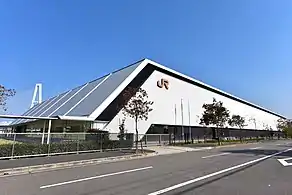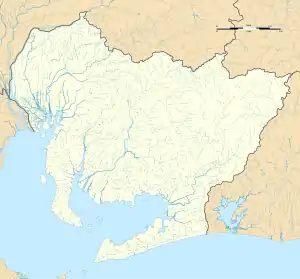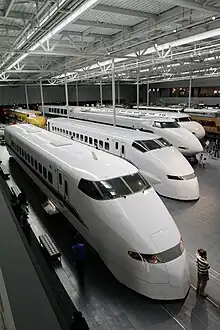リニア・鉄道館 ~夢と想い出のミュージアム~ | |
 The museum exterior in December 2014 | |
 Location of the museum  SCMaglev and Railway Park (Japan) | |
| Established | 14 March 2011 |
|---|---|
| Location | Nagoya, Japan |
| Coordinates | 35°02′50″N 136°50′58″E / 35.04735°N 136.849319°E |
| Type | Railway museum |
| Public transit access | Kinjō-futō Station |
| Website | museum |
The SCMaglev and Railway Park (リニア・鉄道館 ~夢と想い出のミュージアム~, Rinia Tetsudōkan: Yume to Omoide no Myūjiamu) is a railway museum owned by Central Japan Railway Company (JR Central) in Nagoya, Japan.[1] The museum opened on 14 March 2011.[2]
The museum features 39 full-size railway vehicles and one bus exhibit, train cab simulators, and railway model dioramas.[3]
Exhibits
The following full-size vehicles are on display.[3][4]
Shinkansen

JR–Maglev MLX01-1, April 2013

Shinkansen Train Zone, March 2011
- MLX01 SCMaglev car No. MLX01-1 (built 1995 by Mitsubishi Heavy Industries, from JR Research)
- 0 Series Shinkansen car – No. 21-86 (built 1971 by Kisha Seizo, from Hamamatsu Works)
- 0 Series Shinkansen car – No. 16-2034 (built 1986 by Nippon Sharyo, from Hamamatsu Works)
- 0 Series Shinkansen car – No. 36-84 (built 1975 by Hitachi, from Hamamatsu Works)
- 0 Series Shinkansen car – No. 37-2523 (built 1983 by Hitachi, from Hamamatsu Works)
- Class 922 Doctor Yellow car No. 922-26 (built 1979 by Hitachi, from JR West)
- 100 Series Shinkansen car – No. 123-1 (built 1986 by Hitachi, from Hamamatsu Works)
- 100 Series Shinkansen car – No. 168-9001 (built 1985 by Kinki Sharyo, from Hamamatsu Works)
- 300 Series Shinkansen prototype car – No. 322-9001 (built 1990 by Hitachi, from Hamamatsu Works)
- Class 955 "300X" car No. 955-6 (built 1994 by Hitachi, from Hamamatsu Works)
- 700 Series Shinkansen prototype car – No. 723-9001 (ex-set C1, built 1997 by Kawasaki Heavy Industries, on display from 2 January 2014)[5]
- N700 Series Shinkansen prototype car – No. 783-9001 (ex-set X0, built 2005 by Hitachi, on display from 17 July 2019)[6] (displayed outside)
- N700 Series Shinkansen prototype car – No. 775-9001 (ex-set X0, built 2005 by Nippon Sharyo, on display from 17 July 2019, displayed outside)
- N700 Series Shinkansen prototype car – No. 786-9201 (ex-set X0, built 2005 by Nippon Sharyo, on display from 17 July 2019, displayed outside)
Locomotives

C57 139, March 2011
- Class Ke 90 steam locomotive - No. Ke 90 (built 1918, from Nagoya Training Centre) (displayed outside)
- JNR Class C57 steam locomotive - No. C57 139 (built 1940 by Mitsubishi Heavy Industries, from Nagoya Training Centre)
- JNR Class C62 steam locomotive - No. C62 17 (built 1948 by Hitachi, from Higashiyama Park)
- JNR Class ED11 electric locomotive - No. ED11 2 (built 1922 by General Electric, from Sakuma Rail Park)
- JNR Class ED18 electric locomotive - No. ED18 2 (built 1923 by English Electric, from Hamamatsu Works)
- JNR Class EF58 electric locomotive - No. EF58 157 (built 1957 by Mitsubishi Electric, from Hamamatsu Works)
Electric railcars

MoHa 63 electric car MoHa 63638, March 2011
- Class MoHa 1 3rd-class electric railcar - No. MoHa 1035 (built 1922 by Kisha Seizo, from Ina-Matsushima Depot)
- KuMoHa 12 electric railcar - No. KuMoHa 12041 (built 1927 by Kisha Seizo, from Ina-Matsushima Depot)
- Class KuMoHa 52 EMU car - No. MoHa 52004 (built 1937 by Kawasaki Sharyo, from Sakuma Rail Park)
- Class MoHa 63 EMU car - No. MoHa 63638 (built 1947 by Kawasaki Sharyo, from Hamamatsu Works)
- 111 series EMU car - No. KuHa 111-1 (built 1962 by Nippon Sharyo, from Sakuma Rail Park)
- 117 series EMU car - KuHa 117-30
- 165 series EMU car - No. KuMoHa 165-108 (built 1966 by Tokyu Car, from Mino-Ōta Depot)
- 165 series EMU car - No. SaRo 165-106 (built 1967 by Teikoku Sharyo, from Hamamatsu Works)
- 381 series EMU car - No. KuHa 381-1 (built 1973 by Kawasaki Heavy Industries, from Mino-Ōta Depot)
Diesel railcars
- Class KiHa 48000 railcar - No. KiHa 48036 (built 1956 by Tokyu Car, from Sakuma Rail Park)
- Class KiHa 82 DMU car - No. KiHa 82-73 (built 1965 by Nippon Sharyo, from Mino-Ōta Depot)
- KiHa 181 series DMU car - No. KiHa 181-1 (built 1968 by Fuji Heavy Industries, from Sakuma Rail Park)
Steam railcars
- Class HoJi 6005 steam railcar - No. HoJi 6014 (built 1913 by Kisha Seizo)
Passenger carriages
- SuNi 30 passenger carriage – No. SuNi 30 95 (built 1929 by Osaka Tekko, from Sakuma Rail Park)
- OYa 31 passenger carriage – No. OYa 31 12 (built 1937 by Nakata Sharyo, from Sakuma Rail Park)
- OHa 35 passenger carriage – No. OHa 35 206 (built 1941 by Nippon Sharyo, from Sakuma Rail Park)
- MaINe 40 sleeping carriage – No. MaINe 40 7 (built 1948 by Nippon Sharyo, from Sakuma Rail Park)
- 43 series passenger carriage – No. SuHa 43 321 (built 1954 by Niigata Tekko)
- 10 series sleeping carriage – No. ORoNe 10 27 (built 1960 by Hitachi, from Sakuma Rail Park)
Former exhibits
- 300 Series Shinkansen car – No. 323-20 (ex-set J21, built 1993 by Nippon Sharyo, from Hamamatsu Works, removed in December 2013)[5]
- 381 series EMU car - No. KuRo 381-11 (built 1974 by Kawasaki Heavy Industries, from Mino-Ōta Depot, removed in June 2019)[6]
- 117 series EMU cars - MoHa 116-59 + KuHa 116-209 (they were displayed outside, removed in June 2019)[6]
History
Construction work started in August 2009, with the first exhibits moved in from July 2010.[7] The museum opened on 14 March 2011.[2]
On 29 January 2012, a small ceremony was held to mark the one millionth visitor to the museum.[8]
See also
- Kyoto Railway Museum (JR West museum in Kyoto)
- Railway Museum (Saitama) (JR East museum in Saitama Prefecture)
References
- ↑ JR東海博物館(仮称)の名称等の決定について [Name Selected for JR Central Museum] (PDF) (in Japanese). JR Central. 16 September 2010. Retrieved 16 September 2010.
- 1 2 "JR Tokai maglev, train park opens in Nagoya". The Japan Times Online. Japan: The Japan Times Ltd. 15 March 2011. Archived from the original on 12 October 2012. Retrieved 4 January 2014.
- 1 2 "リニア・鉄道館 会館" [SCMaglev and Railway Park opens]. Japan Railfan Magazine. Vol. 51, no. 601. Japan: Koyusha Co., Ltd. May 2011. pp. 64–73.
- ↑ "「リニア・鉄道館」ファーストガイド" ["SCMaglev and Railway Park" First Guide]. Tetsudō Daiya Jōhō Magazine. Vol. 40, no. 324. Japan: Kōtsū Shimbun. April 2011. pp. 20–33.
- 1 2 リニア・鉄道館 700系新幹線電車の展示について [700 series shinkansen exhibit at SCMaglev and Railway Park] (PDF). News release (in Japanese). Japan: Central Japan Railway Company. 13 November 2013. Retrieved 14 November 2013.
- 1 2 3 リニア・鉄道館 N700系車両の展示について [N700 series shinkansen exhibit at SCMaglev and Railway Park] (PDF). News release (in Japanese). Japan: Central Japan Railway Company. 17 May 2019. Retrieved 14 July 2019.
- ↑ JR東海博物館(仮称)建物内への展示車両の搬入について [Installation of exhibits in JR Central Museum] (PDF) (in Japanese). JR Central. 21 July 2010. Archived from the original (PDF) on 19 May 2011. Retrieved 4 January 2014.
- ↑ リニア・鉄道館、来場者100万人達成 [SCMaglev and Railway Park reached one million visitors]. Nikkei Shimbun (in Japanese). Japan: Nikkei Inc. 30 January 2012. Retrieved 4 January 2014.
External links
Wikimedia Commons has media related to SCMaglev and Railway Park.
This article is issued from Wikipedia. The text is licensed under Creative Commons - Attribution - Sharealike. Additional terms may apply for the media files.